A brief update at a busy time of remarkable growth. No dig is a huge help in keeping up to date, most notably because there are fewer weeds to deal with. Nonetheless remove any new weed growth you see, both annuals and perennials.
We just received a wonderful 16 mm/0.6 inch of rain overnight 14th/15th May and there could be more to come. Prior to this the weather has been dry and slightly warm with no frost. Now in this area and I hope for most of you, there are no worries about freezing at night. You can transplant anything.
To save time writing this, I am not labelling my photographs and instead give descriptions in this text. Below are my trial beds 10th May and then four days later, with the no dig bed in front and dig bed behind. Many plantings look quite similar except for the multisown onions, beetroot and spinach. We are harvesting lettuce every week, the radish and turnips are all harvested, and second plantings are in place of beans between fennel, and celeriac between spinach and potatoes.
I’m giving a talk tomorrow evening 16th May at Wareham in Dorset, all about No dig and making your life easier in the garden.



- Sowing
There is less of this for a while.
If you have not already sown them, you can sow chard, spring onions, lettuce, beetroot, carrots, and any brassica for the autumn. Possibilities include Brussels sprouts, cabbages for hearting, kale, cauliflower to harvest in autumn etc. Below left are cabbage and Brussels in cells slightly larger than my CD60.
While it’s possible now to sow purple sprouting broccoli, I prefer sowing mid June, which means you transplant early to mid July after or between first plantings. Say lettuce, broad beans, carrots, salad onions.
Sow basil, cucumbers for outside planting (middle photo is one year old seed of outdoor cucumber), courgettes, and squash for summer cropping. It’s getting late to sow winter squash unless you are in a warm climate. There is still time to sow sweetcorn and celery, but it’s too late for sowing celeriac.
A big sowing this week, if you have not already done it, is summer beans. This can be any kind of climbing beans, and any kind of dwarf French beans will start nicely now, also direct sow outside because of the warmer than usual conditions.
There is still time to plant potatoes, as soon as possible.
If you don’t have it already, my Calendar is now half price at £5 only, with plenty of dates ahead of us for sowings through the summer and into autumn. Succeed with succession.



2. Planting
- Outside: courgettes as in the feature photo, squash of any kind, chard, leeks (any time from now until July), sweetcorn, tomatoes both under cover and outside, cabbage, calabrese, cauliflower, spring onions, lettuce, beetroot
- Under cover, transplant cucumber, melon, aubergine, basil, tomato, watermelon
Transplants can succeed nicely when small. Give a little water to each transplant, then none for two to three days, then water according to weather. The photos below are celeriac on the afternoon we transplanted them 7th May, and then eight days later. You can see that growth is slow but steady and the plants are clearly well established. To left are overwintered spring onions and on the right are turnips which we shall finish soon, because they have increasing amounts of cabbage rootfly!


Plant tomatoes
Tomatoes on the left below are in my small garden and I transplanted the 14th May, filmed by Alessandro Vitale / @spicymoustache. We are making a video about growing outdoor tomatoes, I shall take this through to September, hoping for not too much late blight!
The right-hand photo shows tomato plants in the polytunnel, either side of garlic planted October. The middle photo is cucumber plants which until 14th May were fleeced against cold wind and cool nights. I have now removed the fleece and tied the strings to wires above. My You Tube short has advice on planting with a string in the hole.



Making compost – my next course is 15th June
I hope that you are enjoying the abundance of May, in terms of materials you can add to heaps of compost. A lot of them are in the green category at this time of year, meaning they are fresh leaves and quite high in nitrogen and moisture. At this time of year I never water my heaps, see more details in this recent video. Below I am teaching Compost making at Homeacres, and was at Riverford Field Kitchen garden, where we also had an amazing vegetable meal in the evening.
Best compost results when you add sufficient brown material to these new green ingredients. Browns are quite hard to find at the moment so make a note for next winter to stockpile. They could be tree leaves, wood chippings and shavings left in a damp pile to start decomposing, paper, cardboard and soil. Photo right is one of my current heaps and I’ve just added 30L soil over the top of recently mowed grass.



Cooking up, salads
Catherine Balaam has been serving a delicious food for course lunches and on the left are Dandelion fritters, topped by a flower of California poppy. In the middle I’m with chef Gaz Oakley and it was wonderful to meet him on a course I gave about making compost. We look forward to working together.
The garden on the right is completely new in an Edinburgh pasture. Started in winter by Fred Berkmiller who is owner and chef at L’Escargot Bleu. He is passionate about using fresh vegetables in his menus, and loves the ease of no dig



Amazing growth mid to late May
The photos say it all. Conditions have been highly favourable for growth with a remarkable consistency of temperature. We have had no days above 21 C /70F in the whole year so far, and in May no night temperature lower than 4C° / 39F.
The carrots in my left hand photograph are now covered with mesh and in the 36 hours since I took that photograph, they have almost doubled in size after rain and new warmth. Middle left is a new planting of dwarf French beans, sown just nine days previously, trays on the hotbed.


Potting composts
In my latest video I show the results of using different composts for propagation. The results were not all as I expected, especially the slow initial growth from 4 mm-sieved homemade compost. However, growth was then quicker with every passing day, of multisown radish and lettuce pricked out. Photo left is 9th May, 5 weeks after transplanting with fleece over.
This was confirmed to remarkable effect in another trial of spinach and spring onion plants (see below), grown to full-size in 2L pots of different compost, and two of soil. We have been filming this and it will come out as a video within a month, and I hope you find it as fascinating as I have, to see the different stages of growth according to nutrient release and moisture retention in the different compost materials. As in the propagation video, homemade compost started slowly and finished actually the strongest.
Photo right is 100% homemade compost left, compared right to 75% same homemade with 25% worm compost.


Overview of my second trial at 40 days
There are five bases of compost or soil, lined up in vertical rows below. From the left is Moorland Gold potting compost, then soil, then 4 mm sieved wood about three years old, then mushroom compost which was hot and pretty fresh, then homemade compost about 10 months old. The front row is 100% of each, and further back are additions of worm compost. See the video for more explanation – releasing in about two weeks.













































0 comments